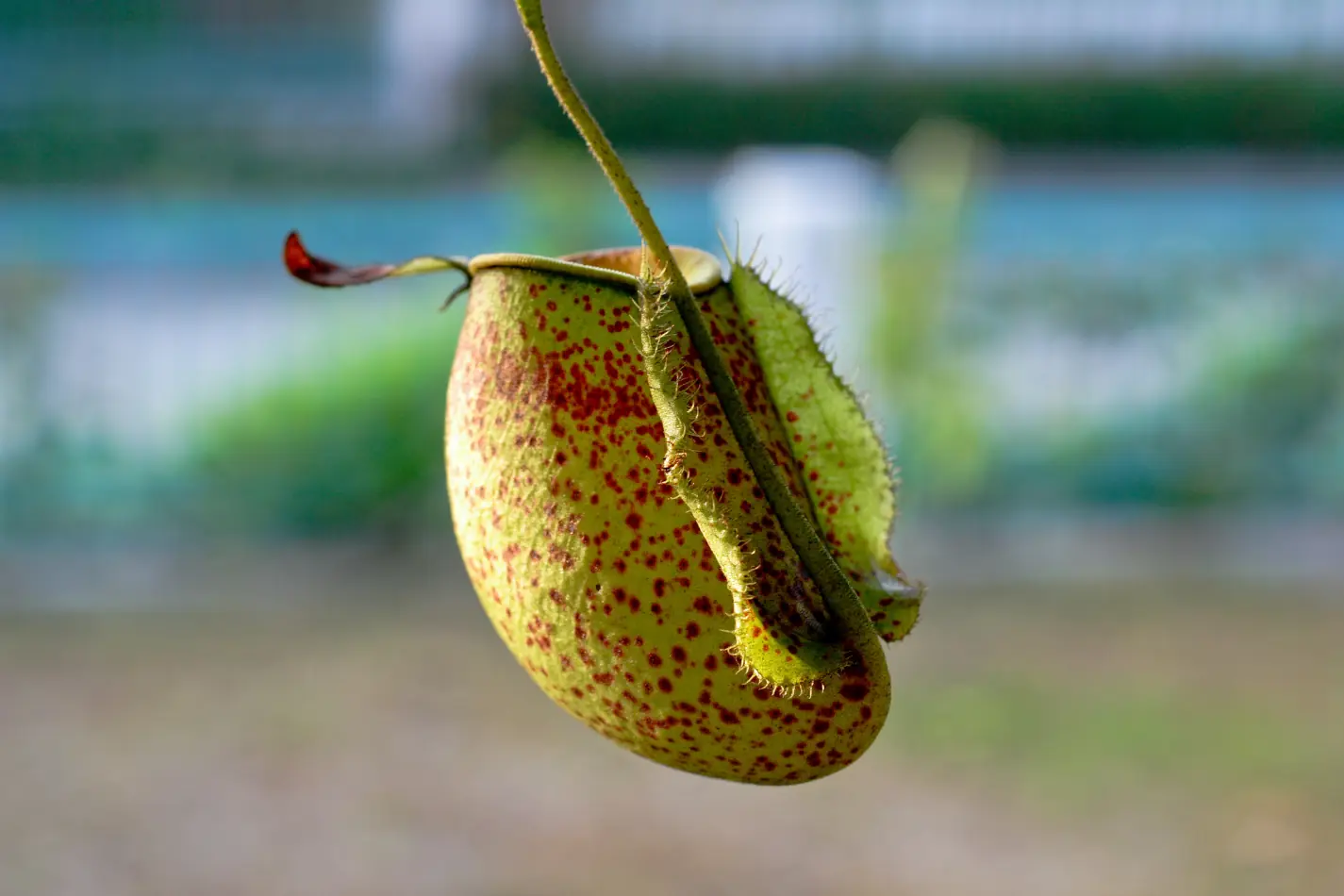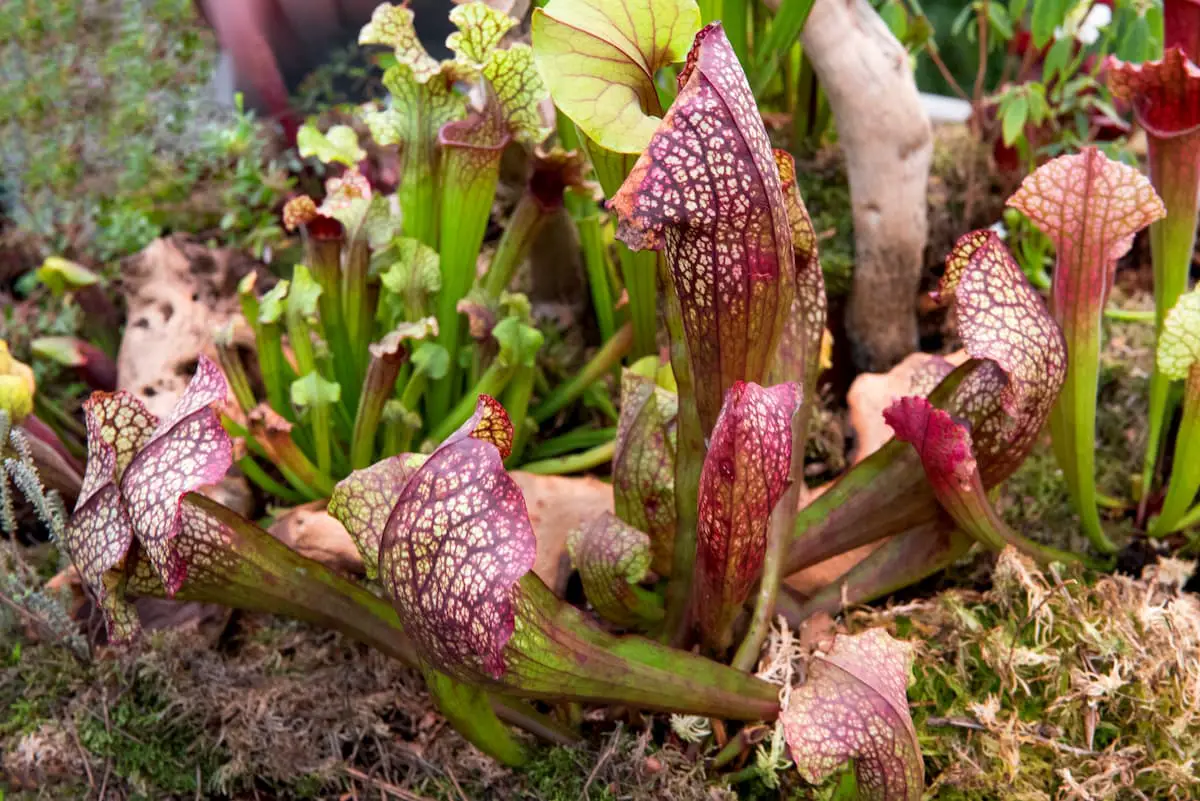If you are looking for pitcher plants, then it is important to know that they need to be fed. This is true for all pitcher plants. The frequency of feeding for a carnivorous plant will depend on the type of plant and where you live versus the natural habitat. Understanding how often you need to feed your pitcher plant is important to their growth and vitality.
Feeding a pitcher plant every two or three weeks is perfect during their active growing season. This makes them one of the simplest and most easy to care for carnivorous plants you can find. Feeding can be through many methods, like drop bugs, fish food, and similar.
Now that we know how often we should look to feed a pitcher plant we should also understand why you should or shouldn’t feed them yourself along with how to care for them indoors as they will have less insect traffic to feed on.
Why You Should or Shouldn’t Feed Them
It is not necessary to feed a Nepenthes pitcher plant in most cases, yet it may be beneficial for the plants’ growth and general health. So, how do you feed tropical pitcher plants, and in what ways?
How to Care for Pitcher Plant Indoors
Pitter plants require no additional fertilizer, however, you may spray them with a dilute fertilizer solution during the spring and summer.
Mix no more than a fourth to a half teaspoon per gallon, using a water-soluble fertilizer specifically designed for bromeliads orchids.
If you want your adult pitcher plant to survive, it must be able to capture a few insects each month. If there aren’t any bugs flying about in your home, offer a recently killed insect now and then, and remember it needs no insecticides.
Only tiny insects should be used since they will easily fit into the pitchers. Don’t overfeed your plants, and don’t offer them pieces of meat as a temptation.
Carnivorous plants have very few nutritional requirements, so don’t give them too much food or fertilizer, and overdoing it is just as bad for their survival.
How To Feed Pitcher Plants
Pitcher plants are probably the most simple carnivorous plants to feed. Drop bugs, fish food, or fertilizer pellets into a few of the pitchers every 2-3 weeks during their active growing season.
If the pitchers are empty, spray them with a pipette or eyedropper after feeding to allow them to absorb the nutrients.
If you shift plants after the pitchers have been filled, be very cautious. Food that has been partly digested from a spilled pitcher has an incredibly noxious odor.
The easiest way to feed Nepenthes is to drop small living insects, fish flakes and crushed pellets, freeze-dried bloodworms, or a light orchid fertilizer into its pitcher.
Always make sure the traps are three-quarters filled with mineral-free water when feeding a pitcher using ONLY distilled water or rain water if addition is needed, never use tap water or fill with excess water.
What You Should Feed Pitcher Plants
There are a number of food for pitcher plants you can feed to your plant, although it is not necessary if they have something to catch naturally.
Feeding them is rarely harmful however and will help the health of your plant in some cases so flakes, pellets, or insects may be used to supplement healthy plants’ nutrition.
Fish Flakes & Crushed Pellets
Fish flakes or crushed koi pellets are an excellent substitute for insects in carnivorous plants. They’re high in several minerals, including animal protein.
As an added benefit these foods are quite simple for a plant to easily absorb. You can also use things like TetraFin Goldfish Flakes and Koi Pellets for simple to deliver nutrition.
Bloodworms
Bloodworms are a great way to add another source of nutrition for carnivorous plants, especially while they’re growing new pots and leaves. This snack is a nutrient-dense meal with all the critical elements Nepenthes pitcher plant needs.
This food can also add wonderful disease resistance to your pitcher plants. Special polymers are located in bloodworm exoskeletons, it is known as chitin. Chitin can help protect plants from many diseases and assists in the development of new tissue.
Carnivorous plants may be able to detect fungal infestations by detecting chitin fragments. These particles activate a plant’s defensive response.
Bloodworms provide more chitin to the plant, making it harder for fungus to develop. In even the most delicate plants such as Butterworts, this defensive mechanism protects them from infections.
Fertilizers
Some fertilizers may be used as a substitute for carnivorous plant food. Oscomote and Maxsea are two examples, but you can easily “overfertilize” your plants with these substances since they are powerful.
That is why I advise you not to use fertilizer for Nepenthes. But, if you want to try and use fertilizer on Nepenthes, good luck.
Different types of carnivorous plants require different sorts of fertilizers. Pitcher-fed fertilizers, for example, are loved by nepenthes pitchers plants. Heliamphora and Sarracenia, on the other hand, will do better when you add fertilizer to the soil.
You should never apply strong fertilizer to your pitcher plants since it will burn the leaves and pitchers. To avoid burning your plants, always dilute the fertilizer with water.
Always fill the pitcher three-quarters full with mineral-free water when using Oscomote or Maxsea.
What You Should Never Feed Pitcher Plants
There are many foods you may think are good for a “carnivorous” plant that can in fact be deadly to them.
Many human-safe foods may seem natural for carnivorous plants, but these foods are not good for your pitcher plant. There is a big difference between what you can eat and what will be healthy for your carnivorous plants to ingest.
Many human-safe foods aren’t appropriate or nutritious enough to feed pitcher plants with them, especially if they’re meant as the sole source of nutrition.
Avoid these things like food for your pitcher plants:
Hamburger
Hamburger is full of bacteria that can harm your pitcher plants leading to the quick death of individual pitchers or the entire plant.
Chicken
Very similar to the hamburger above, chicken isn’t safe for them. Death isn’t the only problem with feeding your Nepenthes this food, though. The decomposing process will lead to a build-up of harmful bacteria in pitcher plants’ soil which can poison them and kill off or weaken individual pitchers or an entire plant over time if not dealt with quickly enough.
Sausage
Another in the line of meats is full of harmful bacteria. Feeding these foods to your pitcher plant can lead to the same problems as mentioned with hamburgers and chicken.
Raw Meats
Using raw meats that aren’t cooked will offer no benefits as pitcher plants in the wild could never catch bigger animals, the raw meats we tend to have are from the wrong animals to the plant’s normal foods.
Candy
Much like cattle, candy is cheap food to fatten up some things but is devastating to a pitcher plant because of its complete lack of nutrients.
How and When to Feed Nepenthes Pitcher Plants?
There are a few different sorts of carnivorous plants. When you feed them nutritious food, you might encounter some problems. Pitcher plants are the most simple carnivorous plants to care for, in my opinion, as there is little “mechanism” to their traps.
However, it’s critical to know when to feed nepenthes and when not to. When they can’t capture insects on a regular basis, they weaken. As a result, their development will come to a halt and in the worst-case scenario, they will perish.
You may still keep them healthy by feeding them the above-mentioned food. Every 2 to 3 weeks, drop fish food, crushed fertilizer pellets, or bugs into a few of the pitchers during their active growing season.
Before putting the meal into the pitcher, make sure it’s not completely dried out. Fill 3/4 of the container with mineral-free) water using an eyedropper or pipette if the pitchers are dry. You may squirt water before or after putting the food in.
If you should see that the food isn’t making it deep into the pitcher then using an eyedropper to push it into the pitcher is preferable.
If pitchers are empty and no water is given to them, they will be unable to obtain nutrients. When the pitchers are full, don’t move the plants. If you must relocate the plants, do so very carefully as the liquids can be incredibly gross smelling when spilled.
Feeding pitcher plants is an uncomplicated process. Here are the steps you need to take:
Choose the Food (Preferably An Insect)
If you pick a dehydrated insect, such as a freeze-dried mealworm, you must rehydrate it before using it to ensure that all the nutrient value is available.
Add a few drops of distilled water into the dehydrated insects and leave it to rest for several minutes until most of the water is absorbed. Then, remove any extra moisture with a towel prior to feeding.
Grab the Food with Tweezers
Tweezers make this task simple, you use them to pick up individual rehydrated insects and put them into the pitcher. If you don’t have tweezers, you could use something like a toothpick to place the insects in.
Drop the Food Inside the Pitcher
Drop each into a pitcher being careful not to overfeed them. You will want to only add a few every couple of weeks while figuring out how much your plant needs.
Repeat As Necessary
You may repeat the process as many times as you’d like, feeding all of the pitchers.
Monitor Plant Pitchers
For the first few weeks, keep an eye on your pitcher plants pitchers, if they begin to show signs of yellowing you may need to re-evaluate what you are feeding and how much.
Additional Pitcher Plant Feeding Tips
It’s not difficult to grow feeding pitcher plants. However, small changes may improve the feeding’s success:
Don’t Drop Bugs or Fertilizer Directly in the Soil
If you’re knowledgeable with fertilizer concentration ratios, it’s fine to feed and fertilize pitcher plants. You must not, however, put any of this directly in the soil.
Pitcher plants are delicate to any mineral accumulation that may occur in the ground.
Feed With Bugs and Insects With Plenty of Soft Tissue
Some insects have greater nutritional value than others. Mealworms and bloodworms are extremely soft, with a high content of nutrients.
Ants and gnats provide advantages, but they are rather tiny for most pitcher plants which then directly increases your needs to feed and manage.
Don’t Drop Water Inside the Pitchers
When feeding, make sure no water or other stuff not containing calories is introduced into the pitchers if they contain liquid already. Water might cause digestive enzymes in the pitchers to become diluted and prevent your plant from consuming insects.
Swap Out Foods
If your plant’s leaves start to mold or die after eating, change the food you’re providing them and look to see if you are following good guidelines on feeding.
Final Thoughts on how often to feed a pitcher plant
In conclusion, it is recommended to feed a pitcher plant about once every two weeks.
Some of the ways you can do this are by using an eyedropper or pipette if the pitchers are dry and placing rehydrated insects with plenty of soft tissue inside them.
To avoid introducing water into the food container, make sure no liquids other than those containing calories have been introduced before feeding.
If your pitcher plants begin to show signs of yellowing after eating, then change their diet as needed and look for good guidelines on how often to feed a pitcher plant in order to improve success rates!



Leave a Reply